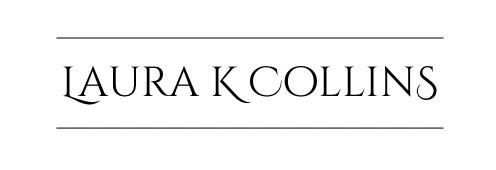40 Helpful Hair Terms To Understand
It’s time to get your hair done! You know what you want, but you just aren’t sure how to ask for it. We’ve all been there before. What are the hair terms you should be using when talking with your hairstylist?
In this post I list 40 common hair terms and their definitions to make it a little bit easier for you to not only explain what you’re looking for, but also easier to understand your stylist when she explains what she’s doing.
***Since I’m sharing the products that I love to use with you guys, this page includes affiliate links to these products. If you take action and purchase a product through clicking one of my links, I’ll make some commission money from it at no extra cost to you. This enables me to be able to continue giving you awesome hair tips, so thanks! ***
19 Hair terms related to hair color
These hair terms will help you to communicate better with your hairstylist during your consultation, as well as enable you to understand what she is talking about when she uses them.
1. Balayage
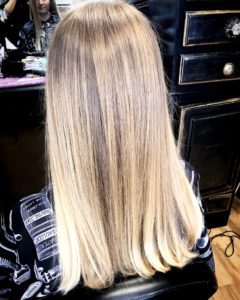
Balayage (bal-ee-age) is a technique in coloring hair, not a look. In this method the hair is hand painted and processed in open air. Some stylists may use plastic, mesh wrap, or cotton to keep the sections separated, but foils are not used.
This method of hair color produces very natural affect with a seamless grow out. The color is typically a warmer shade, so if you want an icy blonde color then your hair may require foils, which is not a true balayage.
Check out my post here to learn more about balayage.
2. Toner
A toner is a demi permanent hair color that is applied to add a tone or shade to the hair, as well as neutralize out any unwanted colors.
If you are a blonde, then your hair probably requires a toner after the highlights are shampooed out. This makes the blonde a specific tone instead of just bleached out highlights.
Toners are often applied at the shampoo bowl and typically only process anywhere from 5-30 minutes. They can make or break a hair color and they are almost always necessary if you have any blonde in your hair.
You can use a toning shampoo or conditioner as an at home toner to freshen up and maintain your tone at home between appointments.
My favorite at home toning shampoos and conditioners are as follows:
- The perfect blonde shampoo and conditioner liter duo Pravana – This toning shampoo and conditioner is for blonde hair to remove unwanted yellow and brassy tones. This purple shampoo does WONDERS for keeping you an icy blonde, months after your color service
- Bust Your Brass Shampoo and Conditioner Amika – Another blonde toning shampoo and conditioner that removes unwanted yellow and brassy tones.
- Viral Colorwash Celeb luxury – Vivid and fantasy color shampoos, adds more color every time you use it.
- Viral Colorditioner Celeb luxury – Vivid and fantasy coloring conditioners. I choose these over the shampoos because they act as a heavy conditioning treatment as well!
- Gem Lites Colorwash Celeb luxury – Natural colored shampoos to refresh faded color or add semi permanent color to hair.
- Gem Lites Colorditioner Celeb luxury – Natural colored conditioners that add color and act as a conditioning treatment at the same time.
3. Level
The level of your hair color is the lightness or darkness. The scale typically goes from 1-10 with 1 being black and 10 being a pale blonde.
If you’d like to learn more about hair color levels and the level system, check out my post here.
4. Shade
The shade of your hair color is the actual color of your hair. Whether it be red, violet, natural, gold, ash, etc. This is what the letters are in hair color language.
To learn more about hair shades check out my post here.
5. Line of demarcation
This hair term is referring to the line where the hair changes. This is typically where your roots begin against your colored, permed, or relaxed hair.
Breakage can occur at this line if the hair is not properly cared for or colored/bleached properly.
6. Oxidize
Oxidizing is the process of hair color mixing with the oxygen in the room and working or processing. When the color is first mixed it may look one shade, and as it oxidizes it will look like a totally different color. This is normal and is the hair color doing its job.
I’ve had several clients panic when they look at the color in the bowl because this is not the color it will make your hair.
Coppers usually oxidize to a purpleish color, and naturals sometimes to a green color. Trust your stylist that she is not putting green color on your hair.
7. Fill
To fill the hair means to add missing color pigment before going darker. When hair is lightened from a dark color to a light, it goes through several brassy stages such as red orange and yellow before it turns to a pale blonde.
When attempting the opposite and going dark from light, those brassy colors must be replaced.
Before applying brown to blonde hair, the hair must be filled with a red, copper, or gold tone (depending on desired end goal) first. This color is basically a toner that is applied, processed, and then is rinsed out. The brown color is then applied over the filled hair.
If the hair is not filled first, the final result will be a lighter, muddy, greenish color that will fade extremely fast.
Depending on the situation, a filler can be added to the brown color instead of being done on a separate process, but this is usually when a smaller change is desired or when the client may want to go back to blonde again soon.
8. Warm
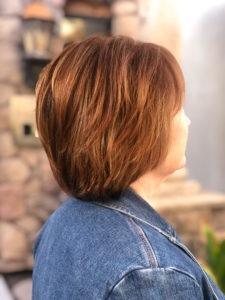
Warmth is used to describe the temperature shade of the hair color. Warm tones are golds, coppers, and reds.
Warm tones often appear lighter than cool tones. They have a more sun-kissed look. When hair color fades it typically takes on a warmer tone than when originally done.
9. Cool
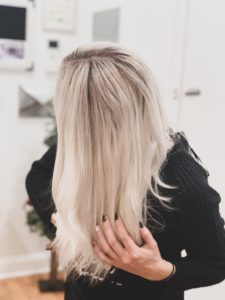
On the other hand, cool tones are beiges, ash, and most violets. These tones are typically more desirable when it comes to blondes.
These tones can appear slightly darker than warmer tones.
10. Brassy
Brassy is the word we use when there is unwanted warmth in the hair color. Think of the color of a penny.
This is typically from the lightening process when the hair is not lightened past a yellow stage. As hair color fades it can also turn into a brassy tone.
This can be corrected with toners and toning shampoos & conditioners.
11. Ashy
When hair has a cool tone we describe it as ashy. Natural virgin hair typically has an ashier tone. Think of the color of ashes or dishwater.
It can also be used to describe the shade of blonde you are looking for, an ashy blonde means it is missing the warmth. This is typically more desired for blondes.
12. Muddy
Hair color becomes muddy if it is not filled properly before going darker. It can be a translucent, ashy, greenish color. Similar to the color of mud.
13. Baby lite
A baby lite is an extremely thinly sliced highlight. Think literally a few hairs at a time. It can be a slice or a weave.
These are typically used around the face and hairline to create very natural looking blonde. It can also be used on the entire head for a much softer look.
14. Ombré
Ombré is the look where the hair is darker at the base or root, and lighter on the ends. It can be high or low contrast.
This can also be reversed with a darker or brighter color added to the ends for a reverse ombré.
15. Lowlights
Lowlights are the exact opposite of highlights. This means you are adding pieces of darker hair color to the hair.
This can also be a red, or any other color as long as it is darker than the base color of the hair.
16. Virgin hair
When we are talking about hair that has not been colored before, we refer to it as virgin hair.
This does not mean hair that has faded or been colored back to its original color. It means that the hair itself is completely unaltered.
Once the altered hair has grown out or has been cut off it is then once again considered virgin hair.
17. Dimension
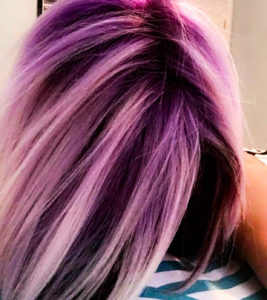
Dimension is the word we use to describe the contrast in hair color. Dimensional hair color has multiple tones and creates depth and movement.
High dimension is created with a higher contrast of colors as well as thicker or chunkier pieces.
Low dimension is more subtle and is created with finer and more similar hair colors.
18. Slice
A slice is the way we pick up a section of hair before we highlight it. This means the hair is sliced in a straight line, color is applied, and it is wrapped up into a foil.
Slices typically create a bolder look or add more dimension depending on what colors are used.
19. Weave
In hair color when we talk about a weave, we are talking about the way we are highlighting.
Instead of slicing the hair before we apply color and wrap it in foil, we weave the hair with a comb to drop out some pieces.
This softens the color being added so it isn’t too prevalent or too harsh.
14 Hair terms related to cutting
The following hair terms are important to ensure you are describing exactly how you like your hair cut. A few of these hair terms may come to a surprise to you because you didn’t realize there was a word for it!
20. Bob
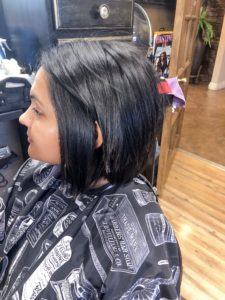
A bob is typically a chin length haircut with little layering.
It can be longer in the front to create an a-line bob, around shoulder/collarbone length to create a lob (long bob), or stacked in the back to create a stacked bob.
21. Lob

As mentioned earlier, a lob is a long bob. These became popular a few years ago and are still hanging on strong.
Lobs are great because you can have the feel of short hair, but still be able to style your hair like you do with long hair with ponytails and curls.
They give you the best of both worlds when it comes to haircuts.
22. Texturize
Texturizing the hair means removing bulk from certain areas to make the hair lay and flow better.
This can help you achieve more volume by removing weight from the ends of your hair, make the hair flip under instead of out, and decrease weight lines from layers.
Texturizing is not only done on thick heads of hair. Frequently fine and thin hair needs to be texturized in order to achieve volume.
Hair is normally texturized when it’s dry and smooth after the hair has been cut wet so that the stylist can see exactly what needs to be adjusted.
23. Blunt
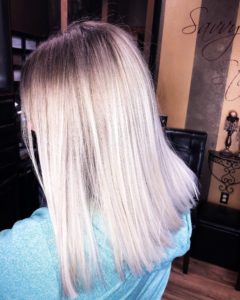
The word blunt typically refers to a harsh straight line. If the haircut is blunt then it is not heavily texturized or layered on the ends. All the hair comes to one clean definate point.
This can be on bangs or the bottom ends of your hair. Blunt haircuts typically look healthier and are also a little higher fashion.
24. Weight line
The weight line in your hair is where the hair is bulkier on one section or line across the hair due to how it is layered.
Sometimes a harsh weight line is desired like in a heavily stacked bob, and other times it is texturized out for a softer look.
25. Disconnected
Disconnection in a haircut is where the layers or levels of hair do not blend or flow in a line.
In a mens cut this is where the sides are shaved and the top is significantly longer with no blend between the two.
It can be done with layers in women’s cuts to create short layers while keeping the length extremely long. Think of an early 2000’s scene haircut.
It can also be done to add drops on bangs where they do not blend into the rest of the hair.
This is typically a higher fashion bolder look.
26. Over directed
Over directing the hair disconnects the haircut without making it too bold. This is frequently done to blend or fix imperfections in the hair.
If a man is balding on top, some hair can be over directed to cover bald spots.
This is also done to create shorter or more layers in longer hair on women without having too choppy of a look.
27. Stacked
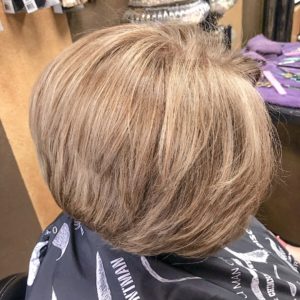
A stacked haircut is typically in the form of a bob. This is when the hair at the nape is layered shorter and the rest of the hair has longer layers.
A heavily stacked bob will have a stronger weight line just above the occipital bone at the base of the skull.
28. Layers
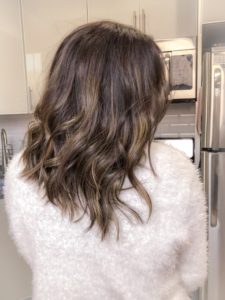
When we talk about layers we are referring to hair that falls to different lengths. This means that the hair is not all one length and does not all come to one point.
Layers can help to show movement in the hair and achieve volume. They create a softer line at the bottom of the hair, so it is less blunt.
29. Undercut
An undercut is any haircut where the hair underneath is cut shorter than the hair above it.
This can be drastic such as a shaved nape or sides, or subtle and unnoticeable to make the hair flip under instead of out.
30. Shag
A shag is a heavily layered haircut. It is typically cut at a 90 degree angle and texturized to create movement in the hair.
This can be a shorter, bob length as well as a longer bra strap length as well. It typically has a bang in the front.
31. Wispy
On the contrary to blunt, the word wispy is used to describe a lighter feathered look on the ends of the hair. It is texturized to remove any weight lines. This is the opposite of blunt.
Many women frequently like this look on their bangs.
32. Razor cut
A razor cut is any haircut that is done with a razor (not clippers). The razor is called a feather razor, and is not a straight razor blade.
It’s typically used to create a more textured, piece-y, and volumized look. Razors can also be used to thin the hair out, but this is not always the case.
33. Dusting
Dusting the hair is when we are taking the bare minimum off of the ends. I only refer to dusting when I am taking less than ¼” off of the hair.
This is typically done on dry hair only.
Other hair terms frequently used
This final category of hair terms can be used with general hair styling, coloring, and cutting.
34. Asymmetrical
The word asymmetrical means that the hair is not the same on both sides. Frequently this is referred to mostly with hair cutting, but can be used with hair color as well.
35. Symmetrical
On the contrary to asymmetrical, Symmetrical hair is even all the way around. This refers to length as well as color distribution.
It does not mean that it is all the same; it just means that it matches from side to side.
36. Diffuse
Diffusing the hair is when the hair is blow dried with an attachment to keep the natural wave pattern.
The attachment stops the hair from being blown around or flattened with the dryer. It is often scrunched while diffused to hold a curl.
37. Face framing

This hair term can be used with color or cuts equally.
In color, face framing highlights are often added to brighten up the look around the face.
In haircutting, face framing typically refers to shorter layers around the face accentuating the jawline.
38. Nape
The nape of the hair is on the back of the head, underneath the ears. It is at the base of the occipital bone.
39. Contrast
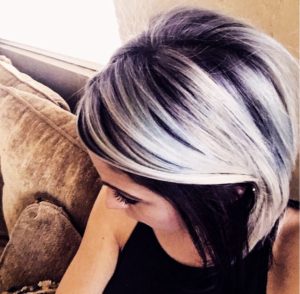
Contrast are the differences in the hair. It is the level of light to dark, the degree from warm to cool, the difference from bold to soft, and the difference from short to long.
High contrast colors are more bold, and low contrast colors are natural and subtle.
40. Subtle
Subtle basically means soft or conservative. This can mean only a slight change or variation.
You may have 2 colors in your hair that are only a small amount different to create a subtle look. Or you add bangs for a subtle change to your haircut.
Keep this list of hair terms handy for your next hair appointment! Knowing how to explain what you want and more importantly what you don’t want is crucial to getting on the same page as your hairstylist and leaving 100% happy!
If you have any further questions for me, leave them in the comment section. And be sure to subscribe below to make everyday a good hair day!
Last updated 06/06/2022
